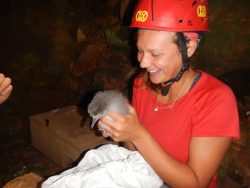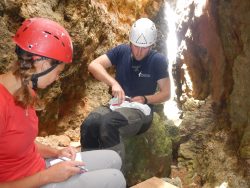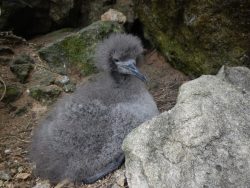The beauty of seabird work is that it is always different. Each species has its own challenges and rewards so two days are never the same. There are some general lessons that you find out though, even as early as day one!
1. The smell
This can be good or bad. The good: shearwaters have a very distinctive smell. We often catch a scent of shearwaters on the breeze, giving us indication to a nearby nest-tunnel and aiding us in our research activities. The bad: seabirds produce seemingly endless amounts of guano. This carries a strong ammonia scent that clings to clothes even after several washes. You quickly learn to wear clothes that you don’t mind getting a bit grubby (although you still develop sentimental attachment to them).
2. Working hours
Working with shearwaters means working long hours at night. Once the sun has dipped below the horizon, it is a matter of waiting for the flurry of shearwater activity that occurs in the hours following sunset and before the moon rises. We sit at the entrance to the nest burrows watching and listening for the first shearwaters to return from their fishing trips at sea. We hope to catch the birds and record important data, such as: the number caught in a night, weight and size of the birds, and whether  they have a metal leg ring or not. This data will help us to understand what is going on with our shearwater populations.
they have a metal leg ring or not. This data will help us to understand what is going on with our shearwater populations.
Later in the season, we play lengthy games of “peek-a-boo” with shearwater fledglings that are taking their first hesitant steps out into the open world to train their wings or even take off from the cliffs on their maiden flights. It is easier catching a fledgling when they’re outside of a burrow than trying to squeeze through the rocky tunnels. When we catch a fledgling, we put a metal leg ring on their left leg, they then wear this ring as if it were a bracelet for their entire life! Each ring has a unique code that is used to identify the bird and in some cases we have years of data on an individual or breeding pair. Once the activity on the cliffs has died down we can head home, often returning in the small hours of the morning to a welcome shower and bed.
3. The battle scars
 Handling seabirds is an absolute joy and privilege. Holding a bird in your hands that has travelled further in its life than you ever will is an incredible feeling. Once the chicks hatch, it only gets better! These balls of fluff are at the beginning of their journey and you can’t help but wonder what their life holds in store for them. Seabirds are apex predators in the marine environment and have evolved a suite of adaptations to assert this claim. The primary prey item of seabirds are fish, therefore a seabird’s bill must be strong enough to catch and hold onto their slippery quarry. When handling a seabird, you quickly learn to keep your fingers away from the sharp, vice-like bill. Unfortunately, one chance is all they need. Once they have a good hold of your fingers there’s not much chance they’ll let go voluntarily. A sure way to tell if someone works with seabirds are small scars across the back of the thumb. They don’t look very impressive, but they’re worn with pride!
Handling seabirds is an absolute joy and privilege. Holding a bird in your hands that has travelled further in its life than you ever will is an incredible feeling. Once the chicks hatch, it only gets better! These balls of fluff are at the beginning of their journey and you can’t help but wonder what their life holds in store for them. Seabirds are apex predators in the marine environment and have evolved a suite of adaptations to assert this claim. The primary prey item of seabirds are fish, therefore a seabird’s bill must be strong enough to catch and hold onto their slippery quarry. When handling a seabird, you quickly learn to keep your fingers away from the sharp, vice-like bill. Unfortunately, one chance is all they need. Once they have a good hold of your fingers there’s not much chance they’ll let go voluntarily. A sure way to tell if someone works with seabirds are small scars across the back of the thumb. They don’t look very impressive, but they’re worn with pride!
4. How to sit still
Seabird work might seem like an adrenaline fueled thrill-ride (abseiling down cliffs, sea-kayaking, avoiding angry adult gulls…) but really these moments are few and far between. Much of our time is filled with long periods of sitting, observing and note-taking. In some cases, a full 24 hours of data collection is required and depending on the man power you have available, a shift could be up to three hours sitting, observing, note-taking. There are ways to make your vigil quite comfortable; a flask of tea, a couple of biscuits and maybe even a cushion of some variety are absolute musts! These long sessions are not without reward; you have front-row seats to the greatest show on earth, seabirds in their natural habitat.
5. How to be a proud parent
The busiest time of year for seabird ecologists is the breeding season. In this brief window of time, you can experience both exceptional highs and terrible lows. Work starts in earnest when the adults return to their breeding colonies, the air is full of courtship calls as lifelong partners reacquaint themselves with one another after long  months apart. As the season enters the egg laying period, a palpable feeling of excitement builds and it is from here that a growing attachment to the fortune of the birds begins. Hatching is always one of the more stressful periods. Small and vulnerable chicks begin to appear across the colony, exposed to both predators and the elements. Observing the changes they undergo from their first day to their fledging date is quite amazing. Within a few short weeks, a chick that is so small and defenseless develops into an organism capable of travelling incredible distances across some of the most inhospitable environments. When the time to fledge finally comes it’s a bittersweet moment as the birds you’ve watched over all season leave for the wide world – happy that they made it this far but sad to see them go. In the days that follow the colony grows quiet and where there once was a hive of activity are now empty nests.
months apart. As the season enters the egg laying period, a palpable feeling of excitement builds and it is from here that a growing attachment to the fortune of the birds begins. Hatching is always one of the more stressful periods. Small and vulnerable chicks begin to appear across the colony, exposed to both predators and the elements. Observing the changes they undergo from their first day to their fledging date is quite amazing. Within a few short weeks, a chick that is so small and defenseless develops into an organism capable of travelling incredible distances across some of the most inhospitable environments. When the time to fledge finally comes it’s a bittersweet moment as the birds you’ve watched over all season leave for the wide world – happy that they made it this far but sad to see them go. In the days that follow the colony grows quiet and where there once was a hive of activity are now empty nests.
By James Crymble, LIFE Arċipelagu Garnija Project Warden
Photos by Martin Austad
